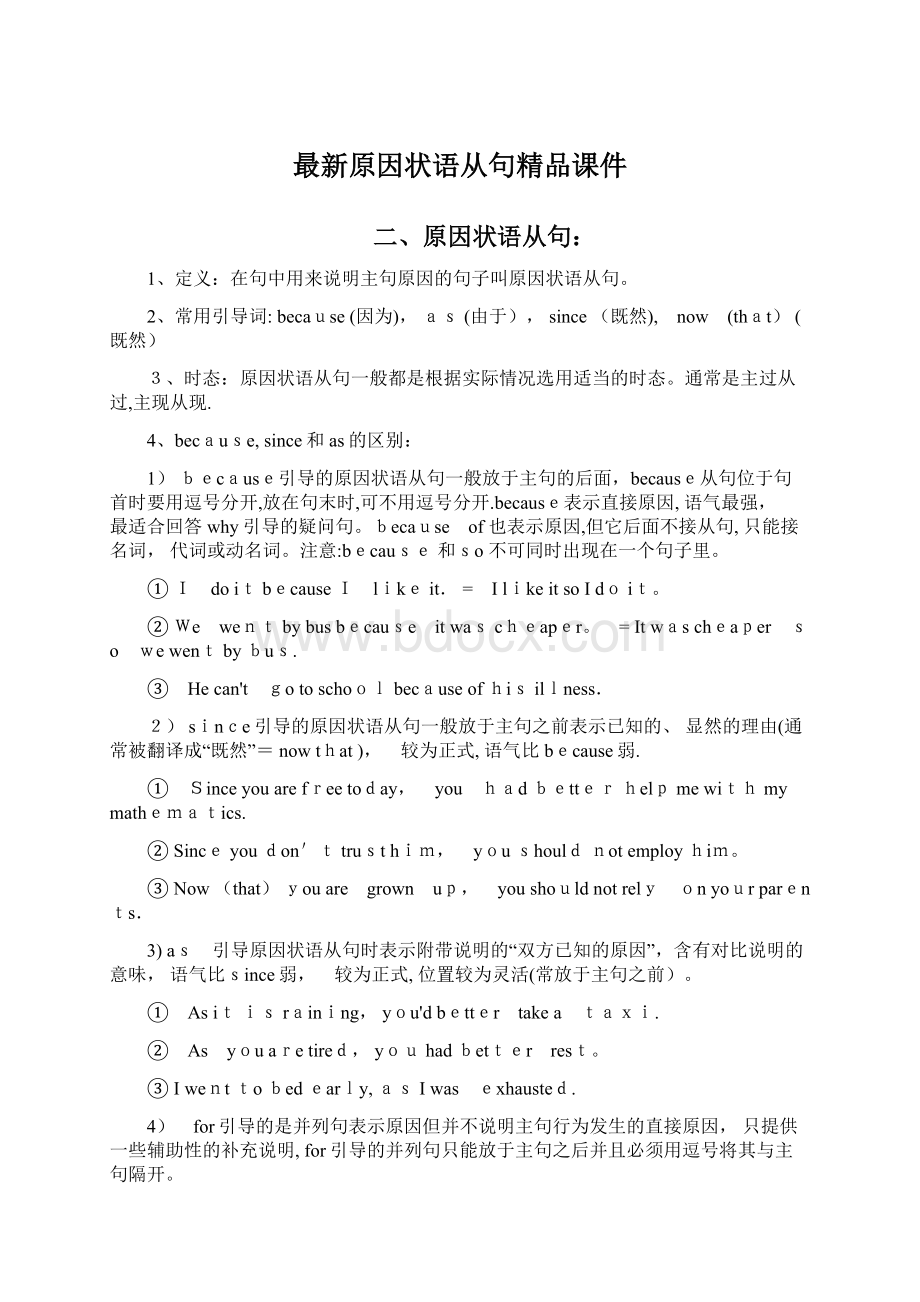最新原因状语从句精品课件.docx
《最新原因状语从句精品课件.docx》由会员分享,可在线阅读,更多相关《最新原因状语从句精品课件.docx(5页珍藏版)》请在冰豆网上搜索。

最新原因状语从句精品课件
二、原因状语从句:
1、定义:
在句中用来说明主句原因的句子叫原因状语从句。
2、常用引导词:
because(因为),as(由于),since(既然), now (that)(既然)
3、时态:
原因状语从句一般都是根据实际情况选用适当的时态。
通常是主过从过,主现从现.
4、because,since和as的区别:
1)because引导的原因状语从句一般放于主句的后面,because从句位于句首时要用逗号分开,放在句末时,可不用逗号分开.because表示直接原因,语气最强, 最适合回答why引导的疑问句。
because of也表示原因,但它后面不接从句,只能接名词,代词或动名词。
注意:
because和so不可同时出现在一个句子里。
①I doitbecauseI likeit.= IlikeitsoIdoit。
②We wentbybusbecause itwascheaper。
=Itwascheaper so wewentbybus.
③ Hecan't gotoschoolbecauseofhisillness.
2)since引导的原因状语从句一般放于主句之前表示已知的、显然的理由(通常被翻译成“既然”=nowthat), 较为正式,语气比because弱.
① Sinceyouarefreetoday, you hadbetterhelpmewithmymathematics.
②Sinceyoudon'ttrusthim, youshouldnotemployhim。
③Now(that)youare grown up, youshouldnotrely onyourparents.
3)as 引导原因状语从句时表示附带说明的“双方已知的原因”,含有对比说明的意味,语气比since弱, 较为正式,位置较为灵活(常放于主句之前)。
① Asitisraining,you'dbetter takea taxi.
② As youaretired,youhadbetter rest。
③Iwenttobedearly,asIwas exhausted.
4) for引导的是并列句表示原因但并不说明主句行为发生的直接原因,只提供一些辅助性的补充说明,for引导的并列句只能放于主句之后并且必须用逗号将其与主句隔开。
①Hecouldnothave seenme,forIwas not there.
② Heseldomgoesoutnow,forheis veryold.
5.
三、目的状语从句:
1、定义:
在句中用来作目的状语的句子叫目的状语从句。
2、常用引导词:
sothat(以便), inorderthat (以便)
3、时态:
目的状语从句一般都是根据实际情况选用适当的时态。
也通常是主过从过,主现从现.
4、目的状语从句应注意以下:
1)目的状语从句中常含有can,could,may, might,should,will,would等情态动词。
I gotup earlyso thatIcould catchthefirstbus。
2) 在口语中so可以引导目的状语从句。
We’llsitnearerthefrontsowecanhearbetter.
3)inorderthat与inorder to的区别:
① inorderthat+从句=sothat+从句
②inorderto+ 动词原形 =so asto+动词原形(不放于句首)=to+动词原形
I getupearlyinordertocatchtheearlybus.
=Igetupearlyinorder that Icancatchtheearly bus。
四、结果状语从句:
1、定义:
在句中用来作结果状语的句子叫结果状语从句。
2、常用引导词:
so…that (如此…以致…),such…that(如此…以致…)
3、时态:
结果状语从句一般都是根据实际情况选用适当的时态。
也通常是主过从过,主现从现。
4、结果状语从句的句型:
结果状语从句的从句部分是补充说明主句中谓语动词发生的结果的,通常位于主句之后。
结果从句中通常不用情态助动词,但must,can,could除外。
结果状语从句其规律由so与such的不同词性决定。
such是形容词,修饰名词或名词词组,so是副词,只能修饰形容词或副词。
so还可与表示数量的形容词many, few,much,little连用,形成固定搭配.
6.
1)so+形/副+that从句
①Theboyissoyoungthathecan'tgotoschool.
② Hespeakssofastthatnoonecancatch him.
2) so+many/few(+复名)+that从句
There aresomany picture-story booksthatthe boywon’tleave.
3)so+much/little(+ 不可数名词)+that从句
Hegave me solittletime thatit wasimpossible forme tofinishthe workontime。
4)so+ 形+a/an+单名+that从句
Itwassohotadaythattheywanted to go swimming.
5)such+ a/an+形+单名+that从句= so+形+ a/an+单名+that从句
Heis such a youngboythathe can'tgo toschool.
= Heisso youngaboythathecan'tgoto school.
6)such+形+复名/不可数名词+that从句
① Theyaresuchfineteachers thatwe allholdthemingreatrespect。
②ItissuchniceweatherthatIwould liketogo tothebeach.
5、结果状语从句与简单句的转换:
1)so…that(从句为肯定句)= …形/副+enough+(for sb.)to dosth。
Heis sooldthathecango to school alone。
=Heisoldenoughto gotoschoolalone.
2) so…that(从句为否定句)=…too+形/副+(for sb.)todosth。
The problemissohard thatIcan'twork itout.
=Theproblemistoohard formetoworkout.
=Theproblemisn’teasyenough formetoworkout.
五、让步状语从句
1、定义:
在句中用来表示“退一步说……”的句子叫让步状语从句。
2、常用引导词:
although(虽然) = though(尽管,即使),nomatter+疑问词=疑问词-ever(无论…),even if = eventhough(即使),whether.。
.or …(不管是…还是…)等。
3、时态:
让步状语从句的时态一般采用主过从过,主将从现的原则。
4、让步状语从句的注意点:
1)although/ though不可与but连用(二者只选其一),但可与still / yet连用.
①Although/Though heisvery old,stillheis quitestrong.
②Although hewas ill, hewenttoschool.=He wasillbuthewenttoschool.
7.
2)nomatter+疑问词=疑问词-ever “无论…"(引导让步状语从句可互换)
① Whatever(=Nomatter what) happened, hewouldnotmind.
② Whoever(=No matterwho)you are,youmust keepthelaw.
③However(=Nomatter how) expensiveitmay be,I’lltakeit.
注意:
“nomatter+ 疑问词”结构只能引导让步状语从句,而 “疑问词-ever”还可以引导名词性从句(主语从句,宾语从句,表语从句和同位语从句)。
④I’lleatwhatever(≠nomatterwhat)yougiveme. (whatever引导宾语从句)
⑤Whoever(≠nomatterwho)comeswillbewelcome. (whoever引导主语从句)
六、条件状语从句
1、定义:
由引导词if或unless引导的状语从句叫做条件状语从句.
2、常用引导词:
if(如果),unless=if…not(如果不/除非),so/aslongas(只要)
3、时态:
条件状语从句的时态常采用主将从现原则.
①Iwill cometosee youif Ihavetime.
②Let'sgooutforawalk unless youaretootired.
=Let’sgo out forawalkifyouarenottoo tired.
③ You can'tlearnEnglishwellunlessyouworkhard.
=You can’tlearnEnglish wellif you don’t workhard.
④Youmayborrowmybookas longasyoukeepitclean.
注意:
“祈使句,+and/or+简单句”是一个固定句型,这里祈使句相当于一个由if引导的条件状语从句:
用and引导的简单句常表示一个较好的结果,用or引导的简单句常表示一个不愉快或不理想的结果;谓语动词常用一般将来时。
即:
祈使句,and+简单句(一般将来时)=Ifyoudosth,you’lldosth。
(这个句型表示“如果做到了祈使句表示的事情,就会有后面句子表示的结果"。
)
Thinkhard ,andyou’llfindaway.=Ifyou think hard,you’ll findaway.
祈使句,or+简单句(一般将来时)= Ifyoudon't dosth,you'll dosth。
(这个句型表示“如果做不到祈使句表示的事情,就会有后面句子表示的结果"。
)
Hurry up, oryou’llbe late. =Ifyoudon’thurry(up), you’llbelate.
8。
[感谢您的阅览以及下载,关注我,每天更新]